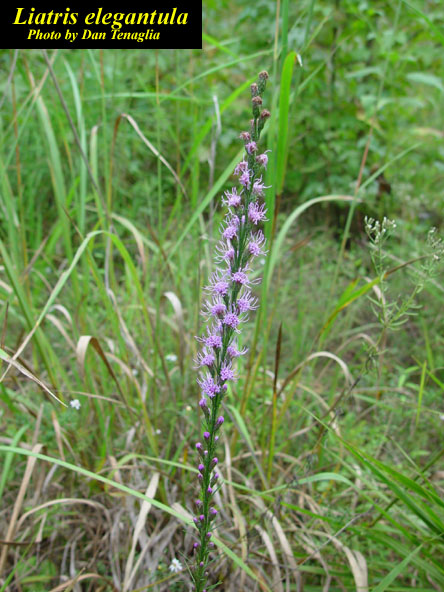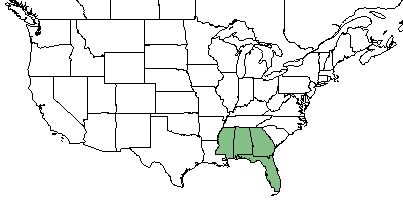Difference between revisions of "Liatris elegantula"
| Line 35: | Line 35: | ||
===Phenology=== <!--Timing off flowering, fruiting, seed dispersal, and environmental triggers. Cite PanFlora website if appropriate: http://www.gilnelson.com/PanFlora/ --> | ===Phenology=== <!--Timing off flowering, fruiting, seed dispersal, and environmental triggers. Cite PanFlora website if appropriate: http://www.gilnelson.com/PanFlora/ --> | ||
| − | + | ''L. elegantula'' flowers from August through November.<ref name="weakley">Weakley, A.S. 2015. Flora of the southern and mid-atlantic states. Working Draft of 21 May 2015. University of North Carolina at Chapel Hill, Chapel Hill, North Carolina.</ref> | |
<!--===Seed dispersal===--> | <!--===Seed dispersal===--> | ||
<!--===Seed bank and germination===--> | <!--===Seed bank and germination===--> | ||
Revision as of 18:33, 16 August 2021
Common name: shaggy blazing star[1]
| Liatris elegantula | |
|---|---|

| |
| Photo by the Atlas of Florida Plants Database | |
| Scientific classification | |
| Kingdom: | Plantae |
| Division: | Magnoliophyta - Flowering plants |
| Class: | Magnoliopsida - Dicots |
| Order: | Asterales |
| Family: | Asteraceae |
| Genus: | Liatris |
| Species: | L. elegantula |
| Binomial name | |
| Liatris elegantula Greene | |

| |
| Natural range of Liatris elegantula from USDA NRCS Plants Database. | |
Contents
Taxonomic Notes
Synonyms: Liatris graminifolia Willdenow var. elegantula (Greene) Gaiser; Laciniaria elegantula Greene; Laciniaria graminifolia (Willdenow) Kuntze.[2]
Varieties: none.[2]
Description
L. elegantula is a perennial forb/herb of the Asteraceae family native to North America.[1]
Distribution
L. elegantula ranges from Georgia, south to northern peninsular Florida, and west to Mississippi.[2]
Ecology
Habitat
L. elegantula is found in sandhills and other dry woodlands.[3] Specimens have been collected from drying sand of open pine oak woodland, red clay soils, burned pineland, hardwood stand, peat of savanna, pine flatwoods, limestone glade, broom sedge old fields, longleaf pine wiregrass savanna, sandy old field, borders of hardwood hammock, and on the bank of a river.[4] A study exploring longleaf pine patch dynamics found L. elegantula to be most strongly represented within stands of longleaf pine that are between 180-250 years of age.[5]
Phenology
L. elegantula flowers from August through November.[2]
Conservation, cultivation, and restoration
Cultural use
Photo Gallery
References and notes
- ↑ 1.0 1.1 USDA Plant Database https://plants.usda.gov/core/profile?symbol=LIEL7
- ↑ 2.0 2.1 2.2 2.3 Weakley, A.S. 2015. Flora of the southern and mid-atlantic states. Working Draft of 21 May 2015. University of North Carolina at Chapel Hill, Chapel Hill, North Carolina.
- ↑ Weakley, A. S. (2015). Flora of the Southern and Mid-Atlantic States. Chapel Hill, NC, University of North Carolina Herbarium.
- ↑ URL: http://herbarium.bio.fsu.edu. Last accessed: June 2018. Collectors: Loran C. Anderson, R.K. Godfrey, K.E. Blum, R. Laxor, A.F> Clewell, S.W. Leonard, Gary Knight, W.G. D'Arcy, Angus Gholson, Wilson Baker, Richard Mitchell, J.P. Gillespie, V. I. Sullivan, Ann Johnson, MacClendons, Geo. Wilder, Paul Redfearn. States and counties: Florida (Wakulla, Madison, Jackson, Leon, Jefferson, lafayette, Clahoun, Gadsden, Levy, Taylor, Dixie, Nassau)
- ↑ Mugnani et al. (2019). “Longleaf Pine Patch Dynamics Influence Ground-Layer Vegetation in Old-Growth Pine Savanna”.